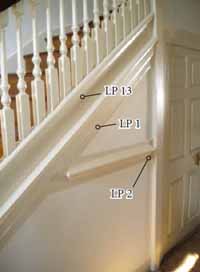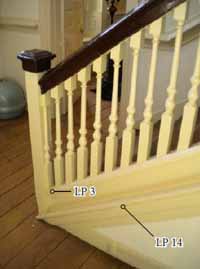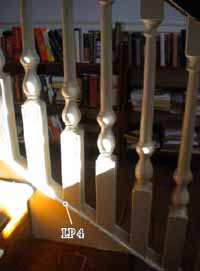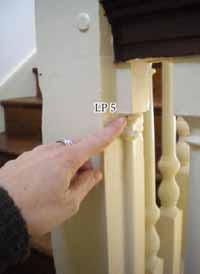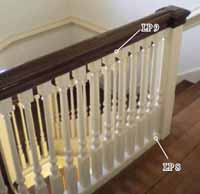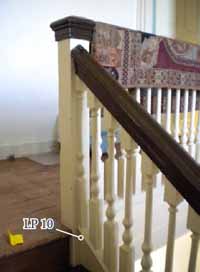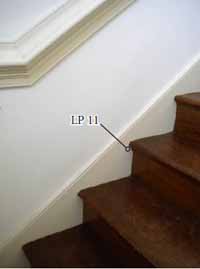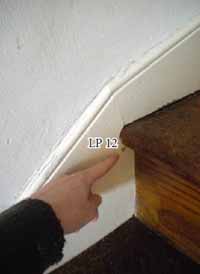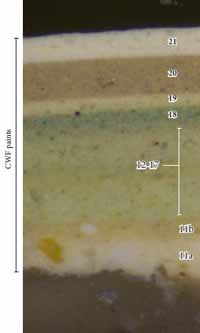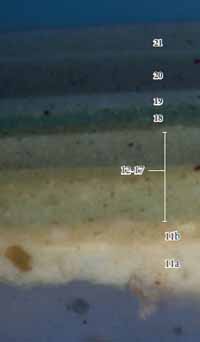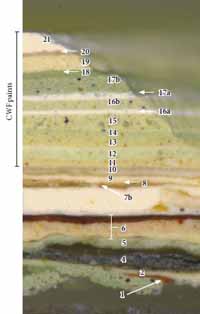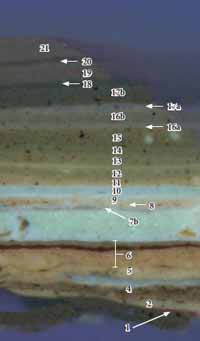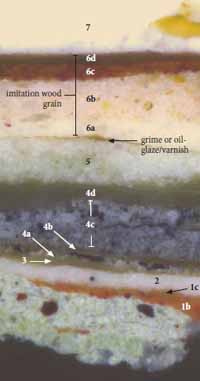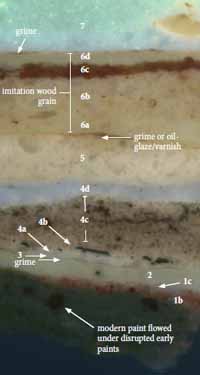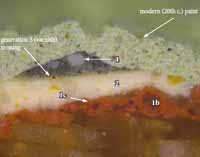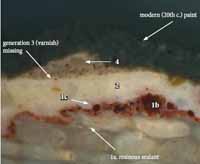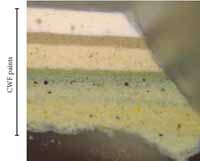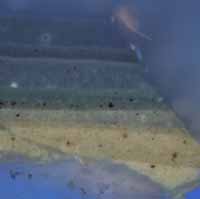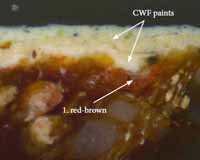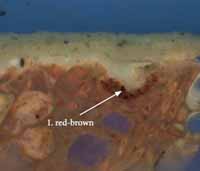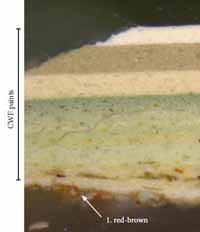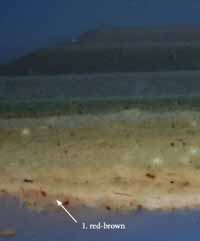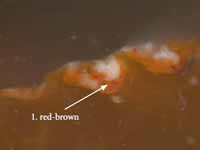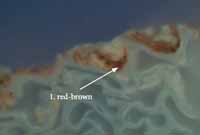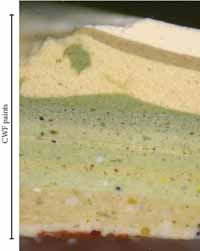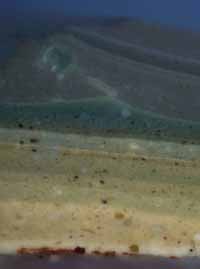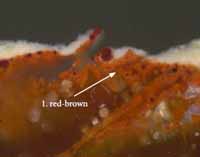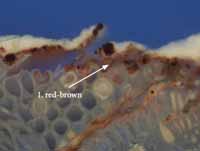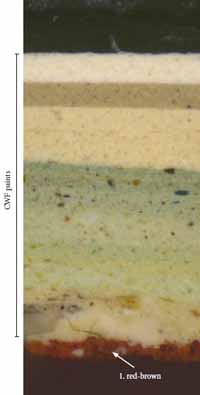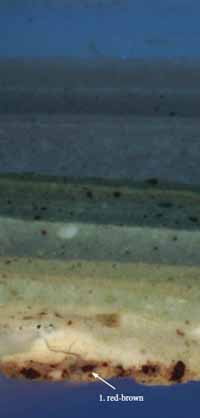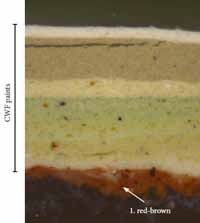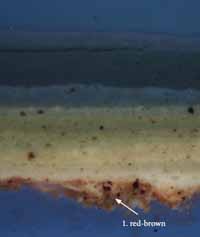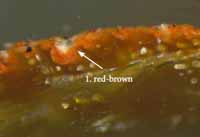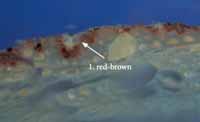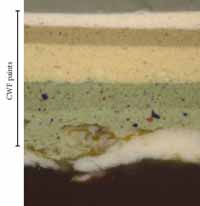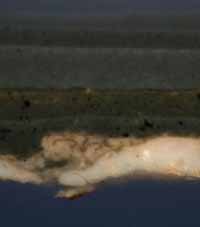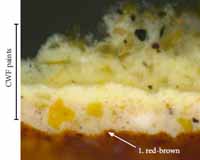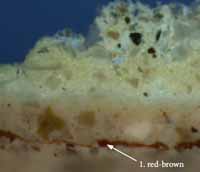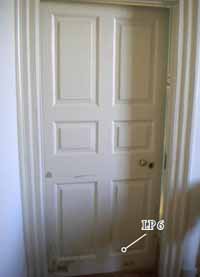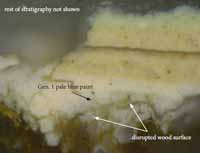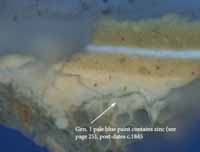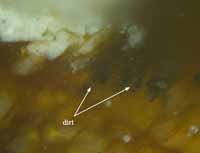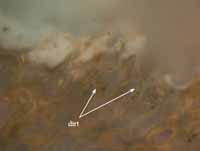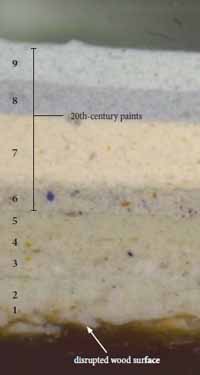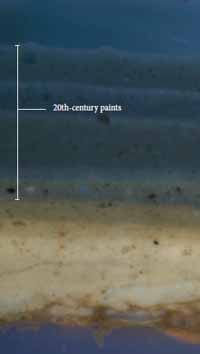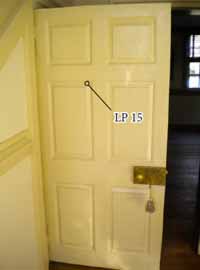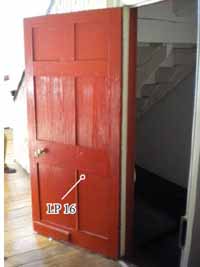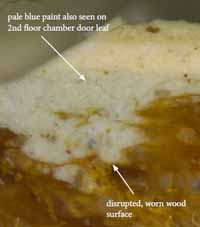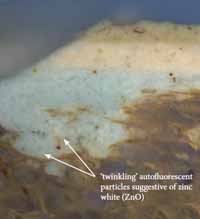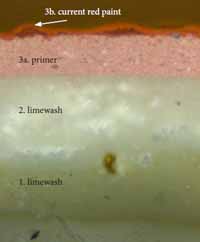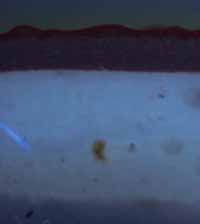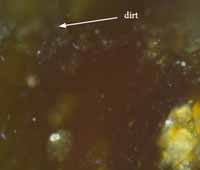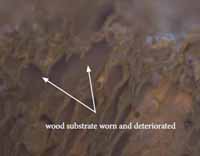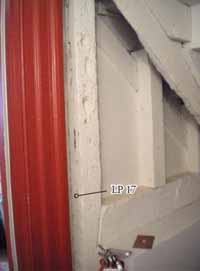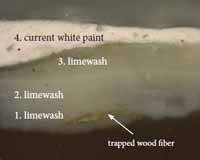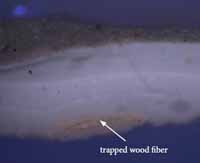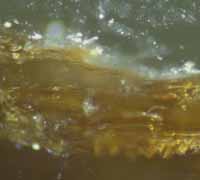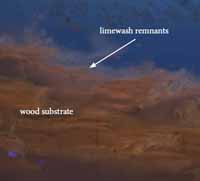Cross-Section Microscopy Analysis of Interior Paints: Ludwell-Paradise House (Block 18, Building 7), Williamsburg, Virginia
Colonial Williamsburg Foundation Library Research Report Series - 1746
Colonial Williamsburg Foundation Library
Williamsburg, Virginia
2013
CROSS-SECTION MICROSCOPY ANALYSIS REPORT
Ludwell-Paradise House Interior
Block 18, Building 7
COLONIAL WILLIAMSBURG FOUNDATION
WILLIAMSBURG, VIRGINIA
TABLE OF CONTENTS
| Purpose | 2 |
| History/Condition | 2 |
| Procedures | 2 |
| Results | 5 |
| Staircase | 7 |
| Second-floor door leaf to east chamber | 20 |
| First-floor cellar door leaf | 24 |
| Cellar stairwell | 27 |
| Binding Media Analysis Results | 29 |
| Pigment Identification Results | 31 |
| Color Matching Results | 32 |
| Conclusions | 33 |
| References | 34 |
| Appendix A. Procedures | 35 |
| Appendix B. Sample Memo | 38 |
| Appendix C. Memo | 40 |
Cross-section Microscopy Report: Ludwell-Paradise House Interior December 2011
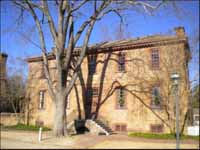 Ludwell-Paradise House (Travers December 2011)
Ludwell-Paradise House (Travers December 2011)
| Structure: | Ludwell-Paradise House, Block 18, Building 7 |
|---|---|
| Requested by: | Edward Chappell, Roberts Director of Architectural and Archaeological Research, Colonial Williamsburg Foundation |
| Analyzed by: | Kirsten Travers, Architectural Paint Analyst, Colonial Williamsburg Foundation |
| Consulted: | Susan L. Buck, P.hD., Conservator and Paint Analyst, Williamsburg, Virginia |
| Date submitted: | December 2011 |
Purpose:
The purpose of this investigation was to use cross-section microscopy techniques to identify the early finish history of original interior woodwork in the Ludwell-Paradise house.
History/Condition:
The Ludwell-Paradise house was built c.1717 by Philip Ludwell of Green Spring, and it was restored by CWF in 1931. According to the architectural report (Moorehead 1933), very little of the interior woodwork is original with the exception of the main staircase newel posts, handrails, stringers, backboards, and stringboard ornaments. All of the balusters are 20th-century reproductions.
The report also suggested that one of the second-floor doors was original to the house: "original door (west wall closet) and frame retained- new trim on room-side applied" (Moorehead 1933, 33). However, on-site examination indicated that the second-floor closet doors were reproduction. Further examination by Edward Chappell suggested that the door leaf to the east second-floor chamber could be original to the house, so samples were taken from this door instead (Appendix C).
There are no architectural fragments from the house in the CWF collection.
Procedures:
On December 13, 2011, seventeen paint samples were collected from the Ludwell-Paradise house interior by Kirsten Travers, accompanied by Ed Chappell, who assisted with the identification of original woodwork and directed sample collection.
4On site, a monocular 30x microscope was used to examine the painted surfaces and determine the most appropriate areas for sampling. A microscalpel was used to remove the samples, which were labeled and stored in small individual Ziploc bags for transport. All samples were given the prefix "LP" and numbered according to the order in which they were collected. All sample locations were documented and recorded.
In the laboratory, the samples were examined with a stereomicroscope under low power magnification (5x to 50x), to identify those that contained the most intact paint evidence and would therefore be the best candidates for cross-section microscopy. Uncast sample portions were retained for future examination and analysis. The best candidates were cast in resin cubes and sanded and polished to expose the cross-section surface for microscopic examination.
Once cast, the cross-section samples were examined and digitally photographed in reflected visible and ultraviolet light conditions at 20x to 400x magnifications. By comparing the resulting photomicrographs, finish generations could be interpreted based on physical characteristics such as color, texture, thickness, presence of dirt layers and extent of surface deterioration. Fluorochrome staining was also carried out on selected samples to characterize pigments or the types of binding media present (oils, carbohydrates, proteins). The most informative photomicrographs and their corresponding annotations, as well as comments from the author, are contained in the body of this report. All raw photomicrographs can be found in the Appendix at the end of this report.
Results:
Only one sample, LP 1, taken from the staircase east partition architrave, contained the most complete stratigraphy from which all other samples could be compared. The paint history is as follows:
| Generation | Layer | Description | Notes |
|---|---|---|---|
| 21 | 21 | present cream paint (CWF) | — |
| 11-20 | — | applied by CWF: yellows, mostly greens, recent tans/browns | determined via baluster sample LP 5 |
| 10 | 10 | gray paint | contains zinc white (ZnO) |
| 9 | 9b | varnish | — |
| 9a | cream-colored paint | — | |
| 8 | 8 | peach-colored paint | — |
| 7 | 7b | varnish | — |
| 7a | white paint | contains zinc white (ZnO), after c.1845 | |
| 6 | 6d | varnish (+ grime) | possibly plant resin |
| 6c | red graining layer | — | |
| 6b | pink base coat | — | |
| 6a | cream-colored primer | — | |
| 5 | 5 | pale blue (+ grime or oil-based varnish) | — |
| 4 | 4d | varnish | possibly plant resin |
| 4c | dark gray paint | very thick, same as 4a | |
| 4b | varnish | possibly plant resin | |
| 4a | dark gray paint | very thin, same as 4c | |
| 3 | 3 | varnish | inconsistent, seen only in LP 1 |
| 2 | 2 | cream-colored paint (+ grime) | oil-bound, possibly lead white and yellow ochre pigments |
| 1 | 1c | varnish | possibly plant resin, worn |
| 1b | red-brown paint | thin layer, oil-bound with iron oxide pigments | |
| 1a | resinous sealant | possibly shellac |
As shown in Table 1, twenty-one paint generations were identified on the staircase. The first generation consists of a resinous sealant (1a), a coarsely-ground red-brown paint (1b), and a plant resin varnish (1c). This first generation was also found in staircase samples LP 4, LP 8 — LP 10, LP 13 and LP 14, but the rest of the early paint generations were missing. This evidence suggests that much of the staircase was scraped or stripped at some point, possibly in the 20th-century, when the house was restored by CWF.
Due to the fragmentary nature of the earliest finishes, color matching and pigment identification could only be carried out for the first-generation red-brown paint.
The bolection chair board in the passage did not contain any historic paints.
The cellar door leaf and the second-floor east bedroom door leaf were examined on-site by Edward Chappell and both appeared old (see Appendix C.), so samples were taken to determine if 6 they were original to the house. However, no 18th-century finishes were identified on either of the leafs, although the wear and soiling on the surface of the wood substrate suggests the door leafs are old.
The stud in the cellar stairway contains three early unpigmented limewash generations, but it could not be determined if these generations date to the 18th century.
The results in this report are presented according to element, the staircase being discussed first, followed by the door leafs, and the cellar stairway. Where cross-section photomicrographs are shown, paint stratigraphies have been annotated according to finish "generation." For instance, a primer, paint layer, and varnish may represent one finish generation and are all given the same number, but differentiated with lowercase letters (1a, 1b, 1c, etc.), according to the order in which they were applied. Some paint samples contained redundant evidence, so only the most relevant samples are used in the report. Pigment identification with polarized light microscopy, binding media analysis with fluorochrome staining, and color matching are treated in separate sections at the end of the report. All results are interpreted in the conclusion, and all sampling memoranda and raw photomicrographs can be found in the appendix at the back of this report.
STAIRCASE
Summary of results:
Twenty-one finish generations were identified on the staircase. Sample LP 1, taken from the east partition architrave, contained the most complete stratigraphy including the first generation finish from which the early decorative history of the stair could be interpreted. By contrast, sample LP 5 was taken from a baluster which was known to date to the restoration to identify those layers that were applied by CWF.
In the first finish generation, the wood was sealed with a resinous sealant. The pale orange autofluorescence in the wood cells suggests that shellac was used. This was followed by a thin layer of red-brown paint, which is coarsely-ground as if prepared by hand. A clear varnish was then applied over the red-brown paint. The bluish-white autofluorescence of this varnish suggests that it is plant resin-based. Furthermore, this varnish is inconsistent in places and worn, suggesting this first generation was exposed for a relatively long period of time.
The second finish generation is a cream-colored paint with some grime on the surface. This is followed by generation 3, a plant resin varnish. The layer of grime which separates the paint and varnish suggests that some time elapsed before the latter was applied. The varnish might have been applied selectively, as it was only present in one sample (LP 1).
The fourth generation could be some type of dark gray colored faux-finish, as suggested by sample LP 1, which shows that this generation is comprised of multiple layers of paint and varnish. Generation 5 is a pale blue paint, generation 6 is a faux-wood graining finish, and generation 7 is a white paint that contains zinc, which would post-date this coating to c.1845 or later, when zinc white became commercially available (Gettens & Stout 1942). Generations 8-10 are peach, cream, and gray-colored paints, respectively. Generations 11-20 are yellow, tan, and green paints that were applied by CWF since the restoration (this was determined via examination of sample LP 5, taken from a restoration-era baluster). Generation 21 is the present cream-colored paint.
LP 5: half-baluster on newel post on landing, just under cap (restoration-era element)
All of the staircase balusters date to the restoration, and sample LP 5 was taken to establish a baseline for modern paints to which other samples could be compared. The stratigraphy begins with generation 11, a cream-colored paint with some large, coarsely-ground pigment particles that could have easily been mistaken for an 18th-century hand-ground paint. The pale orange autofluorescence of generation 11 is suggestive of an oil-based lead paint (Travers 2011).
LP 1: bottom bead of stringer architrave, east partition
Sample LP 1 contained the most complete stratigraphy. The paint history begins with a resinous sealant (1a), a thin layer of coarsely-ground red-brown paint (1b), and a thin layer of varnish (1c). [See following pages for further discussion of early paints]. Some of the samples contain remnants of this first-generation paint, although the remainder of the early paints are missing.
This is followed by a cream-colored paint (generation 2), and thin layer of varnish (generation 3). This varnish appears to have been applied after some dirt had accumulated on the surface of generation 2. This varnish was only found in sample LP 1. It may have been selectively applied.
Generation 4 is a series of dark gray paints and varnishes (see following pages for further discussion). Generation 5 is a pale blue paint (5a), followed by a layer whose dim autofluorescence suggests an oil-based varnish (5b) or a grime layer.
LP 1: bottom bead of stringer architrave, east partition (early generations)
Generation 6 is a faux-wood graining finish, protected by a layer of varnish. This varnish has a distinct layer of grime suggesting this finish was exposed for a long period of time. Generation 7 is a white paint which contains "twinkling" autofluorescent particles that suggest that zinc white (ZnO) is present (Travers 2011), which would indicate this generation post-dates c. 1845 (Gettens & Stout 1942). Generations 8-10 are white and off-white paints. Generation 11-21 are 20th and 21st century paints that were applied by CWF (determined via comparison to sample LP 5, page 9). In the sample above (LP 1c), a modern green paint has flowed beneath the first generation red-brown paint, which would indicate this early generation was flaking when the modern paints were applied.
13This fragment of sample LP 1 contained a good example of the earliest paints. The pale orange autofluorescence in the wood cells (1a) suggests that a resinous sealant, possibly shellac, was used to prepare the wood for painting. This is followed by a thin, coarsely-ground red-brown paint (1b). There is a very thin, inconsistent tannish layer above this red-brown which has a bright bluish-white autofluorescence that is suggestive of a worn plant resin varnish (1c). This would suggest the red-brown is a finish layer, not a primer.
Generation 2 is a cream-colored paint that contains large, coarsely-ground yellow particles. The pale orange autofluorescence of this paint is suggestive of an oil-based lead white paint. In sample LP 1c (previous page), there is an inconsistent varnish over this paint (3). This varnish was not observed in any of the other samples, so it may have been selectively applied.
The fourth generation is a dark gray paint. In sample LP 1c (previous page), this generation appeared to be a complex stratigraphy of grays and varnishes (4a-4d) This could represent some kind of decorative finish, but its exact nature is unclear.
LP 4: west side of bottom rail, east partition, under 7th baluster up from bottom
Sample LP 4 contains remnants of the first-generation red-brown finish in the wood substrate.
The remainder of extant paints appear to date from the restoration up to the present day. This would suggest that this surface was scraped or stripped at some point.
LP 13: First floor, east partition, cyma on stringer cap, between 20th and 21st baluster
Sample LP 13 contains the first-generation red-brown finish in its wood cells.
The remainder of extant paints appear to date from the restoration up to the present day. This would suggest that this surface was scraped or stripped at some point.
LP 14: First floor, east partition, architrave of middle fascia adjoining backband
Sample LP 14 contains the first-generation red-brown finish on the surface of the wood.
The remainder of extant paints appear to date from the restoration up to the present day. This would suggest that this surface was scraped or stripped at some point.
LP 8: second-floor landing, fascia of bottom rail at join of newel post
Sample LP 8 contains the first-generation red-brown finish at the bottom of the sample.
The remainder of extant paints appear to date from the restoration up to the present day. This would suggest that this surface was scraped or stripped at some point.
LP 9: second-floor landing, underside of handrail above 4th baluster out from newel post
Sample LP 9 contains the first-generation red-brown finish deep on the surface of the wood.
The remainder of extant paints appear to date from the restoration up to the present day. This would suggest that this surface was scraped or stripped at some point.
LP 10: second-floor landing, newel post, north face, just below bottom rail
Sample LP 10 contains remnants of the first-generation red-brown finish on the surface of the wood.
The remainder of extant paints appear to date from the restoration up to the present day. This would suggest that this surface was scraped or stripped at some point.
SECOND-FLOOR DOOR LEAF TO EAST CHAMBER
Summary of results:
Two samples were collected from the door leaf to the east chamber on the second floor, one from the passage-side (LP 6), and one from the room-side (LP 7).
The paint history of the passage-side of the door leaf begins with a first generation pale blue paint, which was also found on the cellar door and found to contain zinc, indicating it post-dates c.1845 (see page 25 for fluorochrome staining results). The wood substrate is also very disrupted and worn, suggesting that the door may have been stripped or scraped and earlier paints might have been lost.
The room-side of the door leaf also exhibits a disrupted and worn wood surface with some embedded dirt, suggesting it was originally unpainted and allowed to wear. Extant paints on this side of the door leaf appear to date from the late 19th-century to the present.
Although no 18th-century finishes were identified, the wear and soiling on the surface of the wood substrate suggests the door leaf is old.
Sample LP 6: Passage-side, beveled underside of lower right panel
The early paint stratigraphy seen here on the passage-side of the second-floor east chamber door leaf is the same as that found on the passage-side of the cellar door (LP 15, see page 25). The wood substrate appears very worn, suggesting that early paints, if they did exist, were scraped off at some point.
The first generation applied to the wood substrate is a pale blue paint with a bluish autofluorescence. This same paint was also the first generation on the cellar door (LP 15), which stained positively for zinc (Zn 2+) with the fluorochrome TSQ (see page 25). This suggests that generation 1 is a zinc white paint (ZnO), which post-dates c.1845, when the pigment became commercially available (Gettens & Stout 1942). This would indicate that none of the paints in this sample date to the 18th-century.
Whether this door leaf dates to the 18th-century is uncertain. Although no 18th-century paints are extant, the disruption of the wood substrate suggests that this door could be old.
Sample LP 7: Room-side, right edge of center stile, bottom right panel
The surface of the wood in sample LP 7 is worn and disrupted and contains surface dirt, suggesting the door may have been left unpainted originally.
Nine generations of paint were identified on the room-side of the door (see next page). Generations 1-5 are finely ground and exhibit a peach-colored autofluorescence characteristic of lead-based oil paints. These generations may date to the late 19th-early-20th centuries.
Generations 6-9 are finely ground and exhibit a dim autofluorescence characteristic of synthetic media. These generations most likely date to the mid-late 20th century.
Whether this door leaf dates to the 18th-century is uncertain. Although no 18th-century paints appear to be extant, the dirt embedded in the wood substrate suggests that this door is old.
FIRST-FLOOR CELLAR DOOR LEAF
Summary of results:
Two samples were collected from the door leaf to the cellar, one from the passage-side (LP 15), and one from the cellar-side (LP 16).
The paint history of the passage-side of the door leaf begins with a first generation pale blue paint, which was also the first generation on the second-floor east chamber door leaf (see page 21). Fluorochrome staining determined that this paint contains zinc, indicating that the pigment zinc white (ZnO), is present and that this paint post-dates c.1845 (see page 25 for fluorochrome staining results). However, the wood substrate is also very disrupted and worn, suggesting that the door could have been stripped or scraped and earlier paints might have been lost.
The cellar-side of the door leaf contains only three finish generations: two unpigmented limewashes followed by the present red paint. The relative dates of the limewashes could not be determined. This leaf also exhibits a disrupted and soiled wood surface, suggesting it was originally unpainted and allowed to wear.
Although no 18th-century finishes were identified, the wear and soiling on the surface of the wood substrate suggests this door leaf is old.
LP 15: passage-side, bottom ovolo of second rail from top (early paints only)
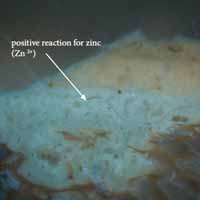 LP 15a, UV light, 400x
LP 15a, UV light, 400x
Stained with TSQ for Zn2+
The wood substrate in sample LP 15 is very disrupted and worn, suggesting this leaf might have been scraped or stripped in the past.
The first generation is the same pale blue paint that was the first generation on the second-floor east chamber door leaf (see page 21). This paint stained positively for the presence of zinc (Zn2+), suggesting that the pigment zinc white (ZnO) is present, indicating this paint post-dates c.1845, when zinc white became commercially available (Gettens & Stout 1942).
This suggests that there are no 18th-century paints on the passage-side of cellar door leaf. The condition of the wood substrate suggests the leaf is old, but the evidence cannot say conclusively that it dates to the 18th-century.
LP 16: cellar-side, bottom right panel just beneath lock rail
The cellar-side of the door leaf contained only three generations of paint. The wood substrate on appears worn and disrupted with a layer of dirt on its surface, suggesting it was originally left unfinished for a substantial period of time. This is followed by two generations of unpigmented limewash (the dates of which could not be determined), and the present scheme— a pink primer (3a) and the present red paint (3b). Although it is unclear if this is an 18th-century leaf, the condition of the wood substrate suggests it is old.
CELLAR STAIRWELL
Summary of results:
The cellar stud contains four finish generations. Generations 1-3 are unpigmented limewashes. Limewash is a common and inexpensive coating that has been used from antiquity to the present day, so it was not possible to assign a relative date to these generations. However, there was no dirt on the surface of the wood, and this could suggest that the limewashes were applied relatively early in the history of the house.
BINDING MEDIA ANALYSIS RESULTS
LP 1: bottom bead of stringer architrave, east partition (early generations. See page 13).
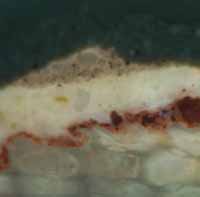 LP 1a, UV light, 400x
LP 1a, UV light, 400x
Before TTC stain for carbohydrates
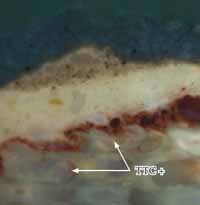 LP 1a, UV light, 400x
LP 1a, UV light, 400x
TTC reaction
A weak reaction for carbohydrates (dark red-brown color), was observed in the resinous material in the wood substrate, but no other reactions were observed in the sample.
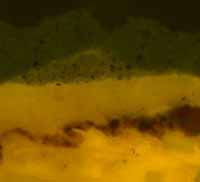 LP 1a, B-2A filter (EX 450-490nm, BA 520nm), 400x
LP 1a, B-2A filter (EX 450-490nm, BA 520nm), 400x
Before FITC stain for proteins
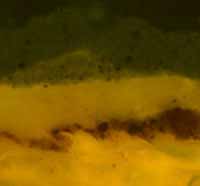 LP 1a, B-2A filter (EX 450-490nm, BA 520nm), 400x
LP 1a, B-2A filter (EX 450-490nm, BA 520nm), 400x
FITC reaction
There was no reaction (bright yellow-green fluorescence), observed when the sample was stained with FITC for proteins.
LP 1: bottom bead of stringer architrave, east partition (early generations)
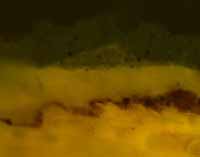 LP 1a, B-2A filter (EX 450-490nm, BA 520nm), 400x
LP 1a, B-2A filter (EX 450-490nm, BA 520nm), 400x
Before DCF stain for lipids (oils)
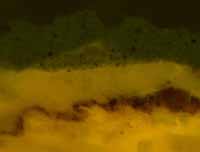 LP 1a, B-2A filter (EX 450-490nm, BA 520nm), 400x
LP 1a, B-2A filter (EX 450-490nm, BA 520nm), 400x
DCF reaction
There was no reaction (bright yellow-green fluorescence), observed when the sample was stained with DCF for lipids (oils).
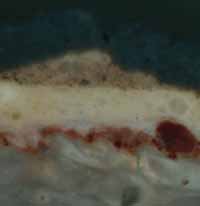 LP 1a, UV light, 400x
LP 1a, UV light, 400x
Before RHOB for lipids (oils)
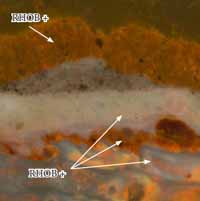 LP 1a, UV light, 400x
LP 1a, UV light, 400x
RHOB reaction
The sample was stained again for lipids with the fluorochrome Rhodamine B (RHOB). Strong reactions (bright red fluorescence) were observed in the resinous sealant (1a) and the first generation red-brown paint (1b). In addition, a weaker reaction was observed in the second generation. This would suggest these are all oilbound paints. The reaction in the modern paint at the top of the sample is most likely a false positive resulting from additives in industrially-prepared paints.
Generation 1b: Red-brown paint
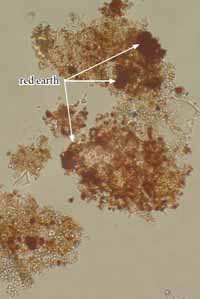 LP 14, red-brown paint (1b) pigment sample, plane
LP 14, red-brown paint (1b) pigment sample, plane
polarized light, 1000x
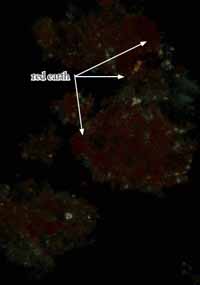 LP 14, red-brown paint (1b) pigment sample, cross
LP 14, red-brown paint (1b) pigment sample, cross
polarized light, 1000x
An intact area of the first generation red-brown paint was sampled from LP 14 for pigment identification (see page 16 for cross-section photomicrograph). Pigment scrapings were collected with a clean scalpel blade from the uncast portion of the wood substrate that had red pigments embedded in the fibers. The sample was dispersed on a glass slide and mounted with Cargille Meltmount (refractive index = 1.66) for polarized light microscopy.
Agglomerations of small red particles were observed. These are red-orange in transmitted light and isotropic (dark) under crossed polars. This is suggestive of an iron oxide pigment, such as red earth (Fe2O3 ‧ nH2O) (Eastaugh 2008, Gettens & Stout 1942).
None of the other early paints (such as generations 2 and 4), could be isolated for pigment identification.
COLOR MATCHING RESULTS
Generation 1b: Red-brown paint
 Underside of uncast fragment of LP 8, visible light, 100x
Underside of uncast fragment of LP 8, visible light, 100x
Color readings from the first-generation red-brown paint could not be obtained with the Minolta Chroma Meter colorimeter/microscope, as most examples of this coating were extremely fragmented and disrupted. Instead, the closest commercial color match was determined by eye using a stereomicroscope at 30x magnification with a color corrected light source. The closest commercial match is between two colors- Colonial Williamsburg CW-109 "Palace Arms Red" (which was a little too red) and Benjamin Moore 2104-30 "Harvest Brown" (not red enough).
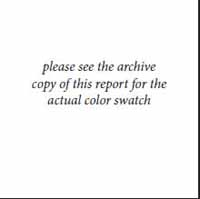 Colonial Williamsburg
Colonial Williamsburg
CW-109 "Palace Arms Red"
| CIE | Munsell |
|---|---|
| L* 32.11 | H 8.0R |
| a* +28.57 | V 3.1 |
| b* +19.84 | C 6.8 |
 Benjamin Moore
Benjamin Moore
2104-30 "Harvest Brown"
| CIE | Munsell |
|---|---|
| L* 38.46 | H 9.1R |
| a* +17.63 | V 3.8 |
| b* +13.56 | C 4.2 |
Conclusions
This investigation found enough paint evidence on the staircase to begin to understand the early finish history of the interior of the Ludwell-Paradise house.
Staircase: The first finish generation is a resinous sealant applied to the wood, followed by a coarsely-ground oil-bound red-brown paint made with red earth pigments. This was followed by a clear plant resin varnish, which would have lent the red-brown paint a glossy appearance. Furthermore, this varnish is rather worn which suggests that this red-brown was exposed for a long period of time.
The second generation is an oil-bound cream-colored paint. In the third generation, after some grime had accumulated on the surface of this paint, it appears to have been selectively varnished, as suggested by sample LP 1. This varnish was missing from all other samples.
The third generation is an oil-bound dark gray paint that sample LP 1 suggests may consist of multiple layers of paint and varnish, indicative of a faux-finish, such as imitation marble. The true nature of this generation would have to be explored via on-site excavation to reveal early finishes. However, the cross-section evidence suggests this generation is fragmentary, at best.
Examination of the staircase paint samples found that only one sample, LP 1, contained a complete stratigraphy from which the above early finish history was extrapolated. Other samples contained remnants of the first-generation red-brown, but little else in the way of historic paints. Therefore, other decorative schemes, such as polychromy, cannot be ruled out.
Door leafs: Both sides of the cellar door leaf and the second-floor east bedroom door leaf were sampled. The finish evidence on the east bedroom leaf and the passage side of the cellar leaf both contain a zinc white (ZnO) paint applied directly to the wood substrate. This post-dates the earliest paint after c.1845, when this pigment was introduced, and indicates that none of the extant paints date to the 18th-century. On the cellar-side of the cellar leaf, there were two unpigmented limewash layers applied to the wood, but these could not be confidently assigned to the 18th- century. However, it was noted that the wood substrate on all of the doors was extremely worn and soiled, which could suggest that these doors were allowed to wear significantly before being painted. This could suggest that the door leafs are old, but it is still uncertain if they date to the 18th-century.
Cellar stairwell: Three unpigmented limewash layers (generations 1-3) and one modern paint (generation 4) were found on the cellar stud adjacent to the doorway to the passage. As with the door leaf, it was not possible to assign a relative date to these limewashes. However, there was no dirt on the surface of the wood which could suggest that they were applied relatively early in the history of the house.
References
- Eastaugh, N., et. al. 2008. Pigment compendium: a dictionary and optical microscopy of historical pigments. Oxford, Butterworth-Heinemann.
- Gettens, R., and G. Stout. 1942. Painting materials: a short encyclopedia. New York, Dover Publications, Inc.
- Moorehead, S. 1933. Ludwell-Paradise house report, block 18, building 7. Unpublished report for the Colonial Williamsburg Foundation.
- Travers, K. 2011. Lead and zinc-based paints in cross-section: a comparative study of elemental composition and autofluorescence behaviors in architectural paints. Unpublished research paper for the Winterthur/University of Delaware Program in Art Conservation.
- Whiffen, M. 1984, revised ed. The eighteenth-century houses of Williamsburg. Virginia. The Colonial Williamsburg Foundation.
- Wolbers, R. 2008. Color and light. Lecture for General Conservation Science ARTC 615, at the Winterthur/University of Delaware Program in Art Conservation.
Appendix A: Procedures
Sample Preparation:
The samples were cast in mini-cubes of Extec Polyester Clear Resin (methyl methacrylate monomer), polymerized with the recommended amount of methyl ethyl ketone peroxide catalyst. The resin was allowed to cure for 24 hours under ambient light. After cure, the individual cubes were removed from the casting tray and sanded down using a rotary sander with grits ranging from 200 - 600 to expose the cross-section surface. The samples were then dry polished with silica-embedded Micro-mesh Inc. cloths with grits ranging from 1500 to 12,000, lending the final cross-section surface a glassy-smooth finish.
Microscopy and Documentation:
The cross-section samples were examined using a Nikon Eclipse 80i microscope equipped with an EXFO X-cite 120 fluorescence illumination system fiberoptic halogen light source. Samples were examined and photographed under visible and ultraviolet light conditions (excitation 330-380 nm, barrier filter 420nm), at 40 to 400x magnifications. Digital images were captured using a Spot Flex digital camera with Spot Advance (version 4.6) software. All images were recorded as 12.6 MB tiff files and stored on a hard drive in a folder titled "Ludwell-Paradise Interior" on Susan Buck's laboratory computer. A separate set of images are stored on the CWF digital database, accompanied by a pdf of this report.
Information Provided by Visible and Ultraviolet Light Microscopy:
When examining paint cross-sections under reflected visible and ultraviolet light conditions, a number of physical characteristics can be observed to assist with the interpretation of a paint stratigraphy. These include the number and color of layers applied to a substrate, the thickness or surface texture of layers, and pigment particle size and distribution within the paint film. Relative time periods for coatings can sometimes be assigned at this stage: for instance, pre-industrial-era paints were hand ground, lending them a coarse, uneven surface texture with large pigment particles that vary in size and shape. By contrast, more "modern", industrially-prepared paints have smoother, even surfaces and machine-ground pigment particles of a consistent size and shape. Furthermore, the presence of cracks, dirt layers, or biological growth between layers can indicate presentation surfaces and/or coatings that were left exposed for an extended period of time.
Under UV light conditions, the presence and type of autofluorescence colors can distinguish sealants, clear coatings, and binding media, from darker dirt or paint layers within the stratigraphy. For instance, shellacs exhibit a distinct orange-colored autofluorescence, while natural resins (such as dammar and mastic), typically fluoresce a bright white color. Oil media tends to quench autofluorescence, while most modern, synthetic paint formulations (such as latex) exhibit no fluorescence at all. Some pigments, such as verdigris, madder, and zinc white, have distinct fluorescence characteristics, as well. UV light microscopy is critical to help distinguish otherwise identical layers often found in architectural samples- such as successive varnishes, or multiple layers of unpigmented (white) limewash.
Binding Media Analysis using Fluorochrome stains:
Fluorochrome stains adapted from the biological sciences were used to characterize the paint binding media (oils, proteins, carbohydrates), in layers within the cross-section sample. The following stains were used in this analysis:
2,7 Dichlorofluorescein (DCF): 0.02% w/v in ethanol. Fluorescent labeling reagent for lipids, particularly drying oils. One drop of stain was applied to the surface of the sample, blotted immediately, and cover-slipped with mineral spirits. The reaction was observed with the B2A filter cube (EX 450-490nm, BA 520nm). This stain exhibits a yellow-green fluorescence where lipids are present.
Triphenyl tetrazolium chloride (TTC): 1.0% w/v in ethanol. Labeling reagent for carbohydrates (gums, starches, cellulosic thickeners). One drop of stain was applied to the surface of the sample, blotted dry, and allowed to sit for approximately 45 seconds before cover-slipping, (must be allowed to react with atmospheric moisture for reaction to move forward). The reaction is observed under reflected UV light conditions (EX 330-380nm, BA 420nm). A dark red-brown color is seen where carbohydrates are present.
Fluorescein isothiocyanate (FITC): 0.02% w/v in anhydrous acetone. Fluorescent labeling reagent for proteins. One drop of stain was applied to the surface of the sample, blotted immediately, and cover-slipped with mineral spirits. The reaction was observed using the B-2A filter cube (EX 450-490nm, BA 520nm). A positive reaction is a bright yellow-green fluorescence.
N-(6-methoxy)-8-quinoly 1-toluene sulfonamide (TSQ): 2% w/v in ethanol. Fluorescent labeling reagent for free Zn2+ ions. One drop of stain was applied to the surface of the sample, blotted immediately, and cover-slipped with mineral spirits. The reaction was observed under reflected UV light conditions (EX 330-380nm, BA 420nm). A bright blue fluorescence, often with "sparkling" particles, is observed where free zinc ions are present.
Pigment Identification with Polarized Light Microscopy:
To collect a pigment sample for polarized light microscopy (PLM), a surgical scalpel was used to collect a small scraping from a clean, representative area of paint. The blade was then pressed and pulled across a clean glass microscope slide, dispersing the pigment particles across the surface. The pigments were then permanently embedded under a cover slip using Cargille Meltmount (refractive index 1.66). The embedded pigments were then examined in cross and plane-polarized transmitted light with the Nikon Eclipse 80i microscope at 1000x magnification (using an oil immersion objective). The observed morphologies (size, shape, agglomeration, cleavage patterns), and optical properties (including color, refractive index, extinction), were compared to reference standards as well as literature sources before making final determinations.
Color measurement and matching:
Color measurements were taken using the Minolta Chroma Meter CR-241 colorimeter/microscope in Susan Buck's paint analysis laboratory. Equipped with an internal 360-degree pulsed xenon arc lamp, this instrument is capable of obtaining accurate color measurements in any one of five different tristimulus color measurement systems from areas as small as 0.3mm. For the purposes of this project, color values in CIE L*a*b* colorspace and the Munsell color system were obtained.
The CIE L*a*b* color space system (developed in 1976 by the Commission International de l'Eclairage, and now an internationally accepted industry-standard color measuring system) uses three numerical values, known as "tristimulus" values, to measure color: L* is the lightness variable, representing dark to light on a scale of 0-100, while a* and b* are chromaticity coordinates, a* representing red to green on scale from -50 to +50, and b*representing blue to yellow on a scale from -50 to +50. These three coordinates are used to plot the location of a color in the CIE L*a*b* colorspace. These resulting values can be used to quantify color differences (ΔE), between two samples. To obtain this value, the following calculation is used:
ΔE = (ΔL*)1/2 + (Δa*)1/2 + (Δb*)1/2A ΔE value = 3 cannot be perceived by the human eye (Wolbers 2008). Therefore, between any two samples, ΔE values at or below this range are considered acceptable matches.
Ideally, color measurements should be collected from a clean, unweathered sample area. If necessary, a scalpel is used to scrape an area clean before color matching. Due to inherent color variations in paints (especially in hand ground, pre-industrial coatings), multiple readings are taken and averaged together to establish the final CIE L*a*b* values.
Due to the deterioration, soiling, and fragmentary nature of some early paints, color readings cannot always be obtained with the Chroma Meter. In these instances, paints are matched by eye to Munsell standard color swatches and commercial paint chips, using a stereomicroscope at 30x magnification with a color corrected light source. Commercial systems consulted include Benjamin Moore, Sherwin Williams, Pittsburgh Paints, and the Colonial Williamsburg Color Collection.
Appendix B. Sample Memorandum
Cc: Susan Buck
From: Kirsten Travers
Date: December 13, 2011
Re: Paint samples from Ludwell-Paradise house interior
Today seventeen paint samples were taken from the interior of the Ludwell-Paradise House. I was accompanied by Edward Chappell, who helped determine the best elements/areas for sampling. The architectural report (Moorehead 1952) stated that most of the staircase was original (balusters excluded), as well as the west closet door leaf in the second-floor west bedroom (bedroom # 9). However, on-site investigation suggested that the only original leaf in that room could be the entrance from the passage.
- LP 1 First-floor, staircase, bottom bead of architrave on stringer, 18 ½" south of cellar door
- architrave
- LP 2 First-floor, staircase, surbase under stringer beneath bolection, 1" above bottom bead and 3" out from cellar door architrave
- LP 3 First-floor, staircase, bead of bottom rail on east partition, adjacent to first-floor newel post
- LP 4 First-floor, staircase, west side of bottom rail on east partition, under 7th baluster up from bottom
- LP 5 Staircase, half baluster (west face) of newel on landing, just under cap
- LP 6 Second-floor, west (east?) bedroom, door leaf from passage, passage-side, lower right panel, beveled edge
- LP 7 Second-floor, west (or east?) bedroom, door leaf from passage, room-side, right edge of center stile, adjacent to bottom right panel in upper left corner
- LP 8 Staircase, second-floor landing, fascia of bottom rail at join of newel post
- LP 9 Staircase, second-floor landing, underside of handrail above 4th baluster from newel
- LP 10 Staircase, second-floor landing, newel post, north face, just below bottom rail
- LP 11 Staircase baseboard against north partition, just under 3rd stair up from landing
- 39
- Cross-section Microscopy Report: Ludwell-Paradise House Interior December 2011
- LP 12 Staircase baseboard against west partition, just under 11th stair up from bottom
- LP 13 First floor, staircase, east partition, cyma on stringer cap, between 20th and 21st baluster
- LP 14 First floor, staircase, east partition, architrave of middle fascia adjoining backband, 24" out from newel post
- LP 15 First floor, cellar door leaf, passage-side, second rail from top, bottom ovolo
- LP 16 First floor, cellar door leaf, cellar-side, bottom right panel, top left corner just under rail
- LP 17 Cellar stairwell, first stud south of doorway in cellar stairwell, 42" up floor
Appendix C. Memorandum (email)
From: Edward Chappell
Date: December 16, 2011
Re: Interior woodwork at the Ludwell-Paradise House — block 18-1, building 7
This summarizes what you and I saw while looking at the woodwork inside the Ludwell-Paradise House when we visited Erin Halleran with Nicholas Chapman and Father John Cox from the Russian Orthodox Church this morning.
As well known, the stair is the principal woodwork original to the house. This includes the molded handrail, newel posts, stringer, and possibly the bottom rail carrying balusters in the passage upstairs. All the balusters date from the restoration. It looks as though the short section of bolection and beaded chair board below the stringer is original, and your observation of the samples should tell us for certain.
The small six-panel door leading to cellar steps is early, but it may be moved in. Both sides of the leaf are weathered, and the inner face is especially weathered, as though it may have originally served a closet with a window and possibly that face was long left unpainted.
The architectural report records that a closet door in the large west (left) upper chamber is original. There is no longer an old door in that location, but I suspect the leaf was moved to the present passage-chamber doorway. It is a relatively small six-panel door of a variety and size one expects to see on closets in expensive c.1750-75 Virginia houses.
Rough structural stringers under the first run of the main stair also look original, with generous waney edges. Individual blocks supporting the steps are made from planed boards, wrought-nailed in place, but I am suspicious that at least some of them may be replacements because they are so crisp and clean compared to the stringers to which they are attached. The stringers and blocks are now painted with recent white paint. The treads and risers in the main run look contemporary with the restoration.
E.A.C
